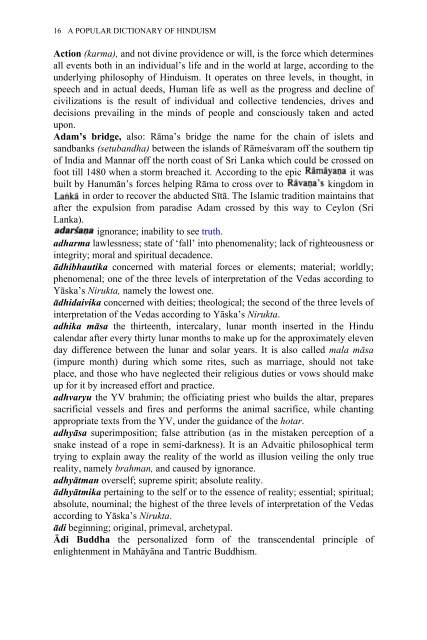You also want an ePaper? Increase the reach of your titles
YUMPU automatically turns print PDFs into web optimized ePapers that Google loves.
16 A POPULAR DICTIONARY OF HINDUISM<br />
Action (karma), and not divine providence or will, is the force which determines<br />
all events both in an individual’s life and in the world at large, according to the<br />
underlying philosophy <strong>of</strong> <strong>Hinduism</strong>. It operates on three levels, in thought, in<br />
speech and in actual deeds, Human life as well as the progress and decline <strong>of</strong><br />
civilizations is the result <strong>of</strong> individual and collective tendencies, drives and<br />
decisions prevailing in the minds <strong>of</strong> people and consciously taken and acted<br />
upon.<br />
Adam’s bridge, also: Rāma’s bridge the name for the chain <strong>of</strong> islets and<br />
sandbanks (setubandha) between the islands <strong>of</strong> Rāmeśvaram <strong>of</strong>f the southern tip<br />
<strong>of</strong> India and Mannar <strong>of</strong>f the north coast <strong>of</strong> Sri Lanka which could be crossed on<br />
foot till 1480 when a storm breached it. According to the epic it was<br />
built by Hanumān’s forces helping Rāma to cross over to kingdom in<br />
in order to recover the abducted Sītā. The Islamic tradition maintains that<br />
after the expulsion from paradise Adam crossed by this way to Ceylon (Sri<br />
Lanka).<br />
ignorance; inability to see truth.<br />
adharma lawlessness; state <strong>of</strong> ‘fall’ into phenomenality; lack <strong>of</strong> righteousness or<br />
integrity; moral and spiritual decadence.<br />
ādhibhautika concerned with material forces or elements; material; worldly;<br />
phenomenal; one <strong>of</strong> the three levels <strong>of</strong> interpretation <strong>of</strong> the Vedas according to<br />
Yāska’s Nirukta, namely the lowest one.<br />
ādhidaivika concerned with deities; theological; the second <strong>of</strong> the three levels <strong>of</strong><br />
interpretation <strong>of</strong> the Vedas according to Yāska’s Nirukta.<br />
adhika māsa the thirteenth, intercalary, lunar month inserted in the Hindu<br />
calendar after every thirty lunar months to make up for the approximately eleven<br />
day difference between the lunar and solar years. It is also called mala māsa<br />
(impure month) during which some rites, such as marriage, should not take<br />
place, and those who have neglected their religious duties or vows should make<br />
up for it by increased effort and practice.<br />
adhvaryu the YV brahmin; the <strong>of</strong>ficiating priest who builds the altar, prepares<br />
sacrificial vessels and fires and performs the animal sacrifice, while chanting<br />
appropriate texts from the YV, under the guidance <strong>of</strong> the hotar.<br />
adhyāsa superimposition; false attribution (as in the mistaken perception <strong>of</strong> a<br />
snake instead <strong>of</strong> a rope in semi-darkness). It is an Advaitic philosophical term<br />
trying to explain away the reality <strong>of</strong> the world as illusion veiling the only true<br />
reality, namely brahman, and caused by ignorance.<br />
adhyātman overself; supreme spirit; absolute reality.<br />
ādhyātmika pertaining to the self or to the essence <strong>of</strong> reality; essential; spiritual;<br />
absolute, nouminal; the highest <strong>of</strong> the three levels <strong>of</strong> interpretation <strong>of</strong> the Vedas<br />
according to Yāska’s Nirukta.<br />
ādi beginning; original, primeval, archetypal.<br />
Ādi Buddha the personalized form <strong>of</strong> the transcendental principle <strong>of</strong><br />
enlightenment in Mahāyāna and Tantric Buddhism.


















